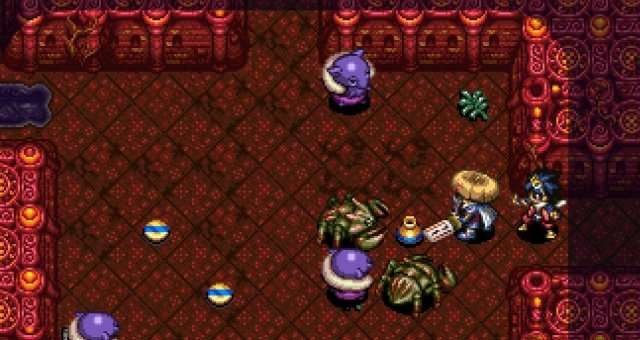
This guide help you defeat your arch-nemesis. The one foe that has plagued us all throughout our entire RPG adventuring careers. It’s about the ever-present, the evil, the indefatigable, the downright scary.
Contents
Guide to Inventory
All credit goes to Shades!
The Situation
By now I’m sure you’re painfully aware that your character only has 24 inventory slots and that those can fill up very quickly if you’re trying to save items for when they’re most needed. Eventually you resort to partly effective strategies like eating food off the ground instead of trying to cram it into your pack or using scrolls immediately whenever it makes sense. You even sell off anything you think you won’t use, whenever the opportunity arises.
But it’s not enough. It’s never enough. Some items need to be switched out depending on circumstances, and when you’re not actively using them you need someplace to put them where they won’t get in your way. So here it is:
The Tools
Ordinary Pot
This comes with 3-5 slots and may very well be the first storage item you find. It’s okay for stashing things that you don’t need to use immediately, but avoid putting any item in there that you think you’ll need within two floors. The reason for this is that you have to break the pot to get your stuff back out, which makes the Ordinary Pot a bit of a pain to use. However, it’s better than nothing at all, and perfectly fine for stowing things you plan on taking back home.
Preservation Pot
This will be the meat and potatoes of our inventory management strategy. Why? Unlike the Ordinary Pot, this pot is reusable! You can access your goodies without breaking it. Look for the ones with a 5 slot capacity and hoard them. The smaller pots will work okay early on, and they are better than not having any at all, but you’ll want to start getting rid of them when you have enough of the larger pots and you’re ready to start consolidating items.
Name It And Claim It
Now you know you can cram pots full of goodies, and that you may or may not need to break them open to take it all back out and use it. Did you also know that you can change the names of your items?
Go into your inventory, select the pot in question, and select “Name”. They’re more like labels, really, but you’ll get to pick a category like Food, Grass, Weapon/Shield. This lets you dedicate each pot to a specific item type. Later on when you sort through your inventory, you won’t be scratching your head so hard trying locate that Rusty Pick that you hastily stashed while running away from the Foly that almost killed you 2 floors ago.
The Strategy
Once we’ve collected enough pots to start organizing, we’ll leverage our hero’s 24 standard inventory slots into something closer to 60. First we’ll need 6 slots for our equipment:
- Weapon
- Shield
- 2 bracers
Preservation Pot labeled Bracer-1 (or whatever you prefer) for storing extra equipment. If you’re like me you’ll wind up switching between several bracers and it might be handy to toss in a pick or other utility item if you have room.
Point Card: once you have it, keep this out. It doesn’t work if it’s inside a pot.
Next, designate one pot for food and two for each of the following:
- Scrolls: utility, navigation, escape, trap destruction, etc.
- Healing: undo/revive grasses, other heals
- Missile: These two pots are our war chest. They’re for the things we use to attack enemies from a distance or with a large area of effect. Arrows, stones, dragon grass, various scrolls and staves.
This next part will depend largely on our current objective. I’ll assume we’re trying to get through the story. We want up to six inventory slots dedicated to pots that aren’t part of our storage system. Incense, Heal, Hilarious, and Hide pots are examples of these. Keeping them on hand is clutch; if we use them well, (along with war chest items), we’ll find ourselves turning bad situations around and needing less undos and rescues.
That leaves 5 slots open for inventory manipulation: collecting items, retrieving stowed gear, etc. If you ever have less than 5 open inventory spaces, that’s your signal to start paring your collection down to keep your inventory manageable. Start looking for items you can use up, sell, drop, or throw as a projectile (preferably by the next floor or sooner).
That’s the basic idea. If your run isn’t focused on beating a dungeon you can reconfigure accordingly (taking less Missile and Heal pots, for example). Just stash the pots in your warehouse if you don’t need them for your next run. You’ll come back and use them later.
The Warehouse
The village of Nekomaneki is extremely hospitable toward wanderers. They’ve even given you a designated warehouse space for stashing your gear! There are other warehouses later on in the game as well; these places are perfect for staging pots you may not need now but want to keep on hand for a future run.
You can also pack up extra things like Dragon Grass or Pickaxes if you wind up with too many. Just find a spare pot, rename it appropriately, and give it the number 8. That way, you know any pot with that number is for stowing extras, and those extras will be easy to find when you need to stock up for that next run.
This is also a useful way to stash things you want to consolidate later like staves. Pack them up, drop them in the Storehouse (menu based storage also in Nekomaneki) and they’ll be there later when you want to fuse them together and free up storage.
Great! Where can I find enough Preservation Pots to do this?
Once you have something called a Points Card, there’s a shop in Nekomaneki that lets you trade your points for different items. You can buy Preservation Pots there for 100 points. You’ll also find them during your regular adventures. It’s very likely you’ll pick up a few while you’re out collecting points.
It takes a little time to collect everything you need, but you’ll get there. Just use what you can in the meantime.
Beware the Birds (and Food Based Monsters)
This method has at least one glaring vulnerability to it.
You’ll eventually find a certain monster type that enjoys kicking dirt at your face. Not only can this ability blind you, but it can also fill your pots if you have empty spaces in them. This can at times be ruinous, because you can’t just reach in and dig the dirt back out. When this happens, it’s probably worth keeping your storage pots. Dirt eventually turns into grass which can then be removed.
There are a few other monsters you should be careful around. Onigiri monsters can turn your items into food. Yes, that includes your storage pots! The first time this happened to me, my (full) food pot transmuted into one *single* Large Onigiri. I was, shall we say, not a happy adventurer. At least it wasn’t my Bracer pot; that would have been a real setback.
A detailed strategy for dealing with these oddball attacks is beyond the scope of this guide (for the moment, at least). However, my favorite method is to position my party so my companions can deal with the unruly pot-destroying offender. Sure, it’s annoying when they get blinded… but not as annoying as having one of my pots ruined!





Be the first to comment